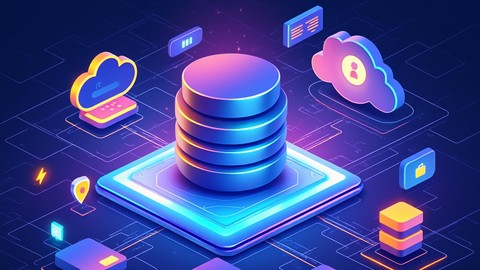
The Complete Guide to Supabase for iOS Developers
The Complete Guide to Supabase for iOS Developers, available at $84.99, with 66 lectures, and has 34 subscribers.
You will learn about Integrate Supabase with iOS Apps: Set up and connect a robust backend using Supabase, tailored for iOS development. Understand Architectural Best Practices: Make informed architectural decisions for seamless Supabase integration into iOS applications. Create and Manage Data Relationships: Master techniques for adding and managing relationships between data tables. Implement Secure User Authentication: Use Supabase’s authentication system to securely manage users in your iOS app. Utilize the Storage API: Store and manage files within your app using Supabase’s storage API. Write and Deploy Edge Functions: Handle complex server-side logic with Supabase’s edge functions. Add Real-Time Capabilities: Enable real-time data synchronization across clients using Supabase’s Real-Time API. Manage User Presence in Real-Time: Use the Presence API to track and manage user presence in real-time applications. Handle Many-to-Many Relationships: Efficiently manage complex many-to-many relationships within your data models. This course is ideal for individuals who are iOS Developers: Developers working on iOS applications who are interested in leveraging Supabase as a backend solution. or Swift Developers: Those familiar with Swift and looking to use Supabase to manage databases, authentication, and real-time functionalities. or Developers Exploring Supabase: Individuals who are new to Supabase and want to learn how to use it effectively with iOS development. or Full-Stack Developers: Developers who handle both front-end and back-end tasks and want to integrate Supabase for the backend of their iOS applications. It is particularly useful for iOS Developers: Developers working on iOS applications who are interested in leveraging Supabase as a backend solution. or Swift Developers: Those familiar with Swift and looking to use Supabase to manage databases, authentication, and real-time functionalities. or Developers Exploring Supabase: Individuals who are new to Supabase and want to learn how to use it effectively with iOS development. or Full-Stack Developers: Developers who handle both front-end and back-end tasks and want to integrate Supabase for the backend of their iOS applications.
Enroll now: The Complete Guide to Supabase for iOS Developers
Summary
Title: The Complete Guide to Supabase for iOS Developers
Price: $84.99
Number of Lectures: 66
Number of Published Lectures: 66
Number of Curriculum Items: 66
Number of Published Curriculum Objects: 66
Original Price: $199.99
Quality Status: approved
Status: Live
What You Will Learn
- Integrate Supabase with iOS Apps: Set up and connect a robust backend using Supabase, tailored for iOS development.
- Understand Architectural Best Practices: Make informed architectural decisions for seamless Supabase integration into iOS applications.
- Create and Manage Data Relationships: Master techniques for adding and managing relationships between data tables.
- Implement Secure User Authentication: Use Supabase’s authentication system to securely manage users in your iOS app.
- Utilize the Storage API: Store and manage files within your app using Supabase’s storage API.
- Write and Deploy Edge Functions: Handle complex server-side logic with Supabase’s edge functions.
- Add Real-Time Capabilities: Enable real-time data synchronization across clients using Supabase’s Real-Time API.
- Manage User Presence in Real-Time: Use the Presence API to track and manage user presence in real-time applications.
- Handle Many-to-Many Relationships: Efficiently manage complex many-to-many relationships within your data models.
Who Should Attend
- iOS Developers: Developers working on iOS applications who are interested in leveraging Supabase as a backend solution.
- Swift Developers: Those familiar with Swift and looking to use Supabase to manage databases, authentication, and real-time functionalities.
- Developers Exploring Supabase: Individuals who are new to Supabase and want to learn how to use it effectively with iOS development.
- Full-Stack Developers: Developers who handle both front-end and back-end tasks and want to integrate Supabase for the backend of their iOS applications.
Target Audiences
- iOS Developers: Developers working on iOS applications who are interested in leveraging Supabase as a backend solution.
- Swift Developers: Those familiar with Swift and looking to use Supabase to manage databases, authentication, and real-time functionalities.
- Developers Exploring Supabase: Individuals who are new to Supabase and want to learn how to use it effectively with iOS development.
- Full-Stack Developers: Developers who handle both front-end and back-end tasks and want to integrate Supabase for the backend of their iOS applications.
Welcome to the Supabase for iOS Developers Course!
Are you ready to elevate your iOS development skills by integrating powerful backend capabilities into your apps? In this comprehensive course, you’ll learn how to harness the full potential of Supabase, an open-source Firebase alternative, specifically tailored for iOS developers.
Whether you’re a beginner just starting your journey or an experienced developer looking to expand your toolkit, this course is designed for all skill levels. Step by step, we’ll guide you through the entire process of integrating Supabase into your iOS applications, covering a wide range of essential topics to ensure you can leverage the platform effectively.
What You’ll Learn:
– Integrating Supabase Database: Set up and connect your iOS app with a robust backend powered by Supabase.
– Understanding Architectural Choices: Learn the best practices and architectural decisions for a seamless integration.
– Adding and Managing Relationships: Master the art of creating and managing relationships between your data tables.
– Authenticating Users: Implement secure user authentication using Supabase’s powerful authentication system.
– Integrating with the Storage API: Store and manage files in your app with Supabase’s storage API.
– Edge Functions: Explore how to write and deploy server-side functions to handle complex logic.
– Real-Time API: Add real-time capabilities to your app, keeping your data in sync across all clients.
– Presence API: Learn how to manage user presence in real-time applications.
– Many-to-Many Relationships: Efficiently handle complex relationships in your data models.
– Edge Functions: Deep dive into advanced server-side logic with edge functions.
Check out the following reviews:
“Incredible Course!”
I was a bit hesitant at first, but this course blew me away. The instructor breaks down complex topics into simple, easy-to-follow steps. I now feel confident integrating Supabase into my iOS apps. Highly recommend it to anyone looking to up their backend game!
— Emily R.
“Practical and Insightful!”
The course content is super practical and immediately applicable. The instructor does an amazing job explaining the architectural choices behind using Supabase with iOS. It really helped me understand the best practices and how to avoid common pitfalls. A must for any iOS developer!
— Sophia L.
“Learned So Much!”
I’ve taken a few courses on backend services, but this one really stood out. The instructor’s teaching style is clear and concise, and the hands-on examples helped me grasp the concepts quickly. The section on edge functions was a game-changer for my projects.
— Liam K.
Thanks,
Azam
Course Curriculum
Chapter 1: Introduction
Lecture 1: Introduction
Lecture 2: Prerequisites
Lecture 3: Exercise Files
Lecture 4: What is Supabase?
Chapter 2: Budget App – Getting Started
Lecture 1: Setting Up Database
Lecture 2: Integrating iOS App with Database
Lecture 3: Implementing Custom Environment Value for Supabase Client
Lecture 4: Fetching and Displaying Budgets
Lecture 5: Saving a New Budget Part 1
Lecture 6: Saving a New Budget Part 2
Lecture 7: Deleting Budget
Lecture 8: Updating Budget
Chapter 3: Budget App – MV Pattern
Lecture 1: Understanding the Architecture
Lecture 2: Loading and Displaying Budgets
Lecture 3: Adding New Budget
Lecture 4: Deleting Budget
Lecture 5: Updating Budget
Chapter 4: Budget App – Relationships
Lecture 1: Creating Expense Table
Lecture 2: Implementing Expense Model and Adding Relationships
Lecture 3: Adding Expense to Budget
Lecture 4: Fetching Expenses (Option 1)
Lecture 5: Fetching Expenses (Option 2)
Lecture 6: Implementing ExpenseListView and ExpenseCellView
Lecture 7: Deleting an Expense
Lecture 8: Updating Expense
Chapter 5: Budget App – Authentication
Lecture 1: Authentication Overview
Lecture 2: Configuring Database to Support Users
Lecture 3: Adding UserId to Budget Model
Lecture 4: Registering a New User
Lecture 5: Signing in a New User
Lecture 6: Navigating to Budgets Screen After Signing in Successfully
Lecture 7: Implementing Sign Out
Lecture 8: Refactor – listenAuthEvents
Chapter 6: Budget App – Storage
Lecture 1: Setting Up Storage Buckets and Updating Expense Model
Lecture 2: Implementing Storage Client Environment Value
Lecture 3: Selecting Images from Photo Library or Camera
Lecture 4: Attaching Receipts to Expenses
Lecture 5: Displaying Receipts
Chapter 7: Budget App – Realtime
Lecture 1: Understanding Realtime and Setting Up Chat Table
Lecture 2: Implementing ChatMessage Model
Lecture 3: Configuring Channel Streams
Lecture 4: Saving Chat Message Part 1
Lecture 5: Saving Chat Message Part 2
Lecture 6: Implementing ChatMessageListView and ChatMessageView
Lecture 7: Adding Text Input and Auto Scroll for Chat Messages
Lecture 8: Resources
Chapter 8: Budget App – Realtime Presence API
Lecture 1: Configure Presence Stream and Implement BudgetStatus
Lecture 2: Handling Presence Joins and Leaves
Lecture 3: Displaying User Status on Screen
Lecture 4: Displaying User Status on Screen (Green and Red)
Lecture 5: Resources
Chapter 9: Budget App – Many to Many Relationships
Lecture 1: What is Many to Many Relationship?
Lecture 2: Adding Tag Model, Updating Expense Model and Fetching Tags for Expense
Lecture 3: Implementing AddTagsView & Displaying Tags on Screen
Lecture 4: Saving Tags to the Database
Lecture 5: Refactoring Saving Receipts
Lecture 6: Associate Tags with Expenses
Lecture 7: Updating Expenses and Tags
Lecture 8: Enable Row Level Security
Lecture 9: Resources
Chapter 10: Budget App – Edge Functions
Lecture 1: What are Edge Functions?
Lecture 2: Configuring your App for Edge Functions
Lecture 3: Deploying and Invoking Edge Functions
Lecture 4: Postgres Webhooks for Edge Functions
Lecture 5: Resources
Chapter 11: Congratulations! You finished the course!
Lecture 1: Next Steps
Instructors
-
Mohammad Azam
Apple Featured iOS Developer and iOS Instructor
Rating Distribution
- 1 stars: 0 votes
- 2 stars: 0 votes
- 3 stars: 0 votes
- 4 stars: 0 votes
- 5 stars: 0 votes
Frequently Asked Questions
How long do I have access to the course materials?
You can view and review the lecture materials indefinitely, like an on-demand channel.
Can I take my courses with me wherever I go?
Definitely! If you have an internet connection, courses on Udemy are available on any device at any time. If you don’t have an internet connection, some instructors also let their students download course lectures. That’s up to the instructor though, so make sure you get on their good side!
You may also like
- Best Public Speaking Courses to Learn in March 2025
- Best Affiliate Marketing Courses to Learn in March 2025
- Best Email Marketing Courses to Learn in March 2025
- Best Social Media Management Courses to Learn in March 2025
- Best SEO Optimization Courses to Learn in March 2025
- Best Content Creation Courses to Learn in March 2025
- Best Game Development Courses to Learn in March 2025
- Best Software Testing Courses to Learn in March 2025
- Best Big Data Courses to Learn in March 2025
- Best Internet Of Things Courses to Learn in March 2025
- Best Quantum Computing Courses to Learn in March 2025
- Best Cloud Computing Courses to Learn in March 2025
- Best 3d Modeling Courses to Learn in March 2025
- Best Mobile App Development Courses to Learn in March 2025
- Best Graphic Design Courses to Learn in March 2025
- Best Videography Courses to Learn in March 2025
- Best Photography Courses to Learn in March 2025
- Best Language Learning Courses to Learn in March 2025
- Best Product Management Courses to Learn in March 2025
- Best Investing Courses to Learn in March 2025






















